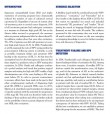Determining high risk for squamous intraepithelial lesion progression in patients with recurrent or persistent HPV 16/18 infection: is there a role for biomarkers?
Prepoznavanje bolnic z visokim tveganjem za napredovanje ploščatoceličnih intraepitelijskih lezij materničnega vratu s ponavljajočo se oziroma trajno okužbo s HPV 16/18: kakšna je vloga biomarkerjev?
DOI:
https://doi.org/10.18690/actabiomed.165Keywords:
human papilloma virus, biomarker, cervical cancerAbstract
Monitoring of low grade and early treatment of recurrent high grade squamous intraepithelial lesions (HSILs) are the cornerstones of cervical cancer prevention. Although current knowledge provides us with the ability to identify patients at risk for redeveloping HSIL, specifically patients with persistent human papilloma virus (HPV) 16 and 18 infection after conization, the danger of surgical overtreatment of these women with persistent infections remains. Complementary diagnostics encompassing the pathobiology of disease progression need to be evaluated. This perspective presents novel evidence that HPV methylation, c-MYC gene methylation, and co-expression of targeting protein for Xenopus kinesin-like protein and programmed death ligand 1 had a positive predictive value in determining which cervical lesions progress to high grade or spontaneously regress.
Downloads

Downloads
Published
Issue
Section
License
Copyright (c) 2018 Acta Medico-Biotechnica

This work is licensed under a Creative Commons Attribution 4.0 International License.